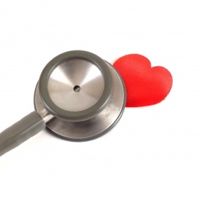February is not just about Valentine’s Day overflowing with chocolate candies filled with creamy sweet caramel, or extra large strawberries dipped in chocolate and decorated with nuts, candies, etc. February is also the month dedicated to heart awareness. So this year do something different for Valentine’s Day and spread love by giving heart awareness tips. 
Did you know that heart disease is the leading cause of death in the United States1. It does not matter whether a person is old or young, anyone of all ages and ethnicity can get the disease! When a heart attack occurs, typically what happens in layman’s terms is that the arteries that supply blood to the heart becomes blocked due to a buildup of fat, cholesterol, or plaque. When this happens the flow that brings oxygen to the heart muscle is severely reduced or stopped. Most times people don’t know when they have had a heart attack, so it is important for people to raise their level of heart awareness and learn the warning signs to prevent this deadline disease from possibly taking a life!
Here are some facts about heart disease from the Center for Disease Control (CDC):
- About 600,000 people die of heart disease in the United States every year-that’s 1 in every 4 deaths.1
- Heart disease is the leading cause of death for both men and women. More than half of the deaths due to heart disease in 2009 were in men.1
- Every year about 935,000 Americans have a heart attack. Of these, 610,000 are a first heart attack. 325,000 happen in people who have already had a heart attack.2
- About 47% of sudden cardiac deaths occur outside a hospital. This suggests that many people with heart disease don’t act on early warning signs.3 Some of the warning signs are chest pain, pain in the arms/neck/back, shortness of breath, Nausea, or cold sweats.
- High blood pressure, high LDL cholesterol, and smoking are key risk factors for heart disease. About half of Americans (49%) have at least one of these three risk factors.4 Other Risk factors are diabetes, obesity, poor diet, lack of exercise and excessive use of alcohol.
What can you do to prevent heart disease?
1. Make Changes in your food consumption with the following recommendations:
- Eat foods that are low in salt (sodium); For an average 2000 calorie American diet, one typically consumes 2300mg of sodium, however, if you are at risk of heart disease, then you should reduce that to 1500mg or less.
- Consume foods that are low in cholesterol; consume less than 300mg for a normal diet. If you are at risk of heart disease, you should consume less than 200mg of cholesterol in a day.
- Eat foods that are low in total fat and eliminate/reduce foods high in trans fat (which comes from partially hydrogenated foods/ingredients); the target recommended for a 2000 calorie daily diet is about 65g. However, if you are are at risk then I recommend between 40 to 50g of total fat (based on a 1200 to 1500 calorie daily diet).
- Consume more vegetables and minimize fruit to no more than two per day. If you’re consuming grains, select whole grains and fiber rich foods.
2. Exercise at least three days per week for at least 30 minutes.
3. Stop smoking.
Lastly, I want to spread some love with my readers and share this video with you; click to watch.
1Kochanek KD, Xu JQ, Murphy SL, Miniño AM, Kung HC. Deaths: final data for 2009 [PDF-2M]. National vital statistics reports. 2011;60(3).
2Roger VL, Go AS, Lloyd-Jones DM, et al. Heart disease and stroke statistics--2012 update: a report from the American Heart Association. Circulation. 2012;125(1):e2-220.
Centers for Disease Control and Prevention. State Specific Mortality from Sudden Cardiac Death: United States, 1999. MMWR. 2002;51(6):123-126.
3CDC. Million Hearts: strategies to reduce the prevalence of leading cardiovascular disease risk factors. United States, 2011. MMWR2011;60(36):1248-51.
Homepage Image courtesy of Suat Eman








Comments
Comments